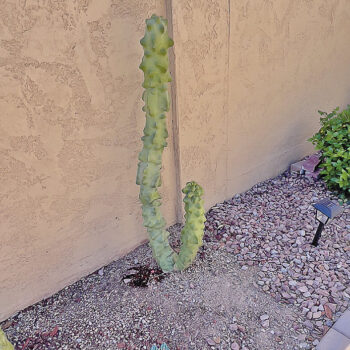 Dannette Hunnel
Dannette Hunnel
If you find that you have the itch to do some planting in June but fear anything will die due to our toasty summers, here is the perfect thing to scratch that itch: the totem pole cactus. It’s reliable, simple, and water-wise. It’s spineless and columnar-shaped and gains multiple arms. It’s also known to be non-toxic, so it’s safe around pets. Having had this extraordinary plant myself in several different homes throughout my tenure in Arizona, I can vouch for its dependability. It’s an absolute sun worshipper that loves intense heat, so no need to worry about shade. A good dose of water weekly is all that is needed. No soil amendment or fertilizer is needed either. Totem pole cacti are not prone to pests.
To purchase one is a small investment, meaning they are not cheap. However, they are perennial, last approximately 10 years, and sprout babies which are easy to propagate. After the sprouts are approximately a foot and a half high on the sides of the totem pole, you can whack them off at the connection site. Leave the newly detached part outside so the new cut site can callous. Leave them on a table outside, out of the sun, for a month. Once the sprouts are dried and calloused, dig a hole about seven inches deep in well-draining soil and place sprouts into the ground, calloused side down. Let the sprouts adjust for 24 hours, then water lightly every other day for two weeks. Then your “new” totem pole cactus will be ready to be on its own. Be cautious about planting location. Never place near a sprinkler system, such as our community sprinklers around our lakes. If the cactus gets black spots, it has developed fungal or chemical damage, probably from the public areas using water and weed chemicals.
Totem pole cacti are slow growing but can get up to 15 feet tall. They are statuesque in appearance and strictly southwestern looking. If you notice they are not growing and appear wrinkly, don’t panic. They are growing underground. Their roots are establishing themselves underground so as to be deep and strong to balance the height of what could be a very tall plant above ground. This will keep them from toppling over during our windy monsoon season. Springtime may bring red fruit the size of an egg—edible fruit that’s easy to snap off, which is recommended, as the birds like them. For winter temps below 32 degrees, place a grocery bag over the top for frost protection. The best thing to remember about this plant is to not overwater, which is an easy thing to remember if you leave during the summer.
